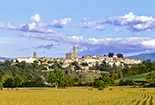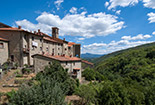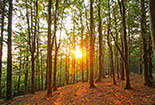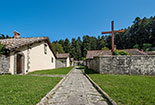LIERNA AND MOGGIONA. Small villages
the Casentino, a Tuscan valley with which you can get familiar in every detail through this site
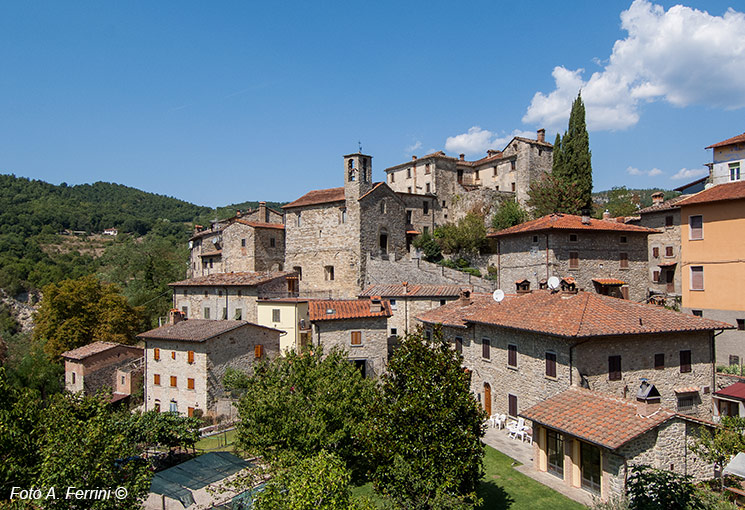
Texts and photos by Alessandro Ferrini ©
36 images in sequence with captions for a virtual journey in the villages of Lierna and Moggiona
Lierna, a medieval castle on the Sova stream
Lierna and Moggiona are two pleasant villages located in the municipality of Poppi. Their story begins for both in the twelfth century, but for very different reasons: the first was a castle of the Guidi, the second was an inhabited area of people dedicated to the work of the forest on behalf of the Camaldolese monks and remained linked to the County of Camaldoli until 1776. Lierna is not far from the beginning of the National Park, Moggiona is the first town of this protected natural area for those arriving from Poppi. Both of these places can be included in an itinerary that leads us to Camaldoli. In this path, with a deviation of a few hundred meters, it is also possible to see the delightful and ancient church of Agna, an example of minor Romanesque architecture in Casentino.
On the road from Ponte a Poppi to Soci, a cross- roads on the left leads to Lierna. From here, then, using the Strada del Corniolino, you can quickly go up to the Hermitage and Monastery of Camaldoli. This little village used to be a castle guarding the below torrent Sova and – in the 12th century – was under the dominion of the Guidis, a power that – during the following century – the Emperor Frederick II confirms to this powerful family. Later, Lierna passed under the dominion of the Guidis of the Romena branch. It stayed under their control until 1367 when the Count Brandino, owner of the castle of Romena, sold everything to the Florentine Republic.
Nowadays, some parts of the ancient castle are still visible, but this is not the main reason why Lierna is worth a visit. Firstly, before arriving to the village, you will be able to see wonderful panoramic views on the Casentino valley and the massif of Pratomagno. Lierna will welcome you with its most modern part, very pleasant too. It is advisable to leave your car in this area and walk just a hundred meters to enjoy the simple but interesting peculiarities of this little village. Its church, given the position on top of the stairway, is going to capture your attention. It is dedicated to San Michele Arcangelo and has very ancient origins. During the centuries, it was the subject to many reconstructions. Its orientation – inverted compared to the origin– is relatively modern. The staircase is clearly modern as well. Beyond the church, it is interesting to observe its apse – here there used to be its facade – embedded among the other buildings. The hamlet is very pleasant and it continues beyond the church for the way it is organized and for the well-kept houses that flank it. The build- ings located in the upper part of the village are a remake of the castle. In some points, portions of the walls of the ancient bridgehouse are still visible.
The church is particularly interesting not only for the pleasant architecture and its elevated posi- tion, but also for the valuable art preserved in its simple single-nave inside.
In particular, three oils on canvas are to be men- tioned. The first of them, attributed to the Sie- nese Pietro Sorri and datable between the late 16th and the early 17th century, represents the Deposition of Christ. In the second, from the early 1640s, the Florentine Giovanni Bizzelli represent- ed the Martyrdom of St Agatha. The third artwork, made in the 1640s by another Florentine – Franc- esco Curadi – shows the Sacrifice of Isaac.
Later, Lierna passed under the dominion of the Guidis of the Romena branch. It stayed under their control until 1367 when the Count Brandino, owner of the castle of Romena, sold everything to the Florentine Republic.
Nowadays, some parts of the ancient castle are still visible, but this is not the main reason why Lierna is worth a visit. Firstly, before arriving to the village, you will be able to see wonderful panoramic views on the Casentino valley and the massif of Pratomagno. Lierna will welcome you with its most modern part, very pleasant too. It is advisable to leave your car in this area and walk just a hundred meters to enjoy the simple but interesting peculiarities of this little village. Its church, given the position on top of the stairway, is going to capture your attention. It is dedicated to San Michele Arcangelo and has very ancient origins. During the centuries, it was the subject to many reconstructions. Its orientation – inverted compared to the origin– is relatively modern. The staircase is clearly modern as well. Beyond the church, it is interesting to observe its apse – here there used to be its facade – embedded among the other buildings. The hamlet is very pleasant and it continues beyond the church for the way it is organized and for the well-kept houses that flank it. The build- ings located in the upper part of the village are a remake of the castle. In some points, portions of the walls of the ancient bridgehouse are still visible.
The church is particularly interesting not only for the pleasant architecture and its elevated posi- tion, but also for the valuable art preserved in its simple single-nave inside.
In particular, three oils on canvas are to be men- tioned. The first of them, attributed to the Sie- nese Pietro Sorri and datable between the late 16th and the early 17th century, represents the Deposition of Christ. In the second, from the early 1640s, the Florentine Giovanni Bizzelli represent- ed the Martyrdom of St Agatha. The third artwork, made in the 1640s by another Florentine – Franc- esco Curadi – shows the Sacrifice of Isaac.
 On the road that from Ponte a Poppi leads to Camaldoli, after 9 kilometers, at 700 meters of height, there is Moggiona. It is the first village, coming from this direction, inside the National Park of the Casentino Forests, Mount Falterona and Campigna.
This place was already cited at the end of the 10th century and it belonged to the parsonage of Arezzo. In 1130, it passed under the jurisdiction of Camaldoli, and thus remained even during the Florentine Republic Dominion first and the Grand Duchy of Tuscany then. Only with the dissolution of the Contea of Camaldoli, 1776, the administration of this place passed to Florence. For over six centuries, the history and the economy of Moggiona were connected to Camaldoli. The village was a control point for those who went to the monastic place and its inhabitants were a sort of employees of the Camaldolese monks. They cut trees, planted firs and worked the wood. The end of the Countea of Camaldoli meant for Moggiona the end of work, so a time of great poverty. People thus started their own business and became specialists in the construction of “bigone”, which means bins for the transportation of grapes in time of harvest. The clients of the artisans were both the local farmers and the great farms in Chianti.
Therefore, the “bigonai” of Moggiona became producers of barrels and many other objects for the production of wine. For almost two centuries, this activity was the economic engine of the village. From this tradition, on the initiative of the local Pro Loco association, the “Bottega del Bigonaio” was created, an exhibition of the products and utensils made for this purpose. Moggiona has also a very sad page of history. During the Second World War, it was the innocent scene of an atrocious Nazi massacre. On 7 September 1944, eighteen people – among them children, women and elders – were execut- ed. In memory of this tragic event and other war episodes involving the village, in Moggiona was created the “Mostra sulla Guerra e la Resistenza in Casentino”(Exhibition on War and Resistance in Casentino), with war material and original documents.
On the road that from Ponte a Poppi leads to Camaldoli, after 9 kilometers, at 700 meters of height, there is Moggiona. It is the first village, coming from this direction, inside the National Park of the Casentino Forests, Mount Falterona and Campigna.
This place was already cited at the end of the 10th century and it belonged to the parsonage of Arezzo. In 1130, it passed under the jurisdiction of Camaldoli, and thus remained even during the Florentine Republic Dominion first and the Grand Duchy of Tuscany then. Only with the dissolution of the Contea of Camaldoli, 1776, the administration of this place passed to Florence. For over six centuries, the history and the economy of Moggiona were connected to Camaldoli. The village was a control point for those who went to the monastic place and its inhabitants were a sort of employees of the Camaldolese monks. They cut trees, planted firs and worked the wood. The end of the Countea of Camaldoli meant for Moggiona the end of work, so a time of great poverty. People thus started their own business and became specialists in the construction of “bigone”, which means bins for the transportation of grapes in time of harvest. The clients of the artisans were both the local farmers and the great farms in Chianti.
Therefore, the “bigonai” of Moggiona became producers of barrels and many other objects for the production of wine. For almost two centuries, this activity was the economic engine of the village. From this tradition, on the initiative of the local Pro Loco association, the “Bottega del Bigonaio” was created, an exhibition of the products and utensils made for this purpose. Moggiona has also a very sad page of history. During the Second World War, it was the innocent scene of an atrocious Nazi massacre. On 7 September 1944, eighteen people – among them children, women and elders – were execut- ed. In memory of this tragic event and other war episodes involving the village, in Moggiona was created the “Mostra sulla Guerra e la Resistenza in Casentino”(Exhibition on War and Resistance in Casentino), with war material and original documents. Of its ancient past, Moggiona has little or nothing to show. The most interesting building is the church dedicated to the Saints Jacopo and Cristopher. Its inside, with one nave, is very pleasant. The altarpiece is very valuable. An oil on canvas attributed to the painter Simone Ferri from Poggibonsi is datable around the last decade of the 16th century and it shows the Visitation of the Virgin to Elisabeth with the Saints Romualdo e Benedetto, in honor of Camaldoli, Jacopo and Cristopher, after whom the church was named.
As already said, Moggiona is located inside the National Park of the Casentino Forests. It is therefore a good starting point for excursions and walks inside this green lung of the Tuscan-Romagnolo Apennines.
The “Percorso del Lupo” (Path of the Wolf) is very pleasant and interesting, an itinerary organized by the Pro Loco and the Ente Parco Nazionale associations, suitable for children, young people and adults, which extends inside the village and the nearby “Bosco di Tega”. Illustrative panels located along the path tell the life and habits of the King of the Casentino Forests.
Of its ancient past, Moggiona has little or nothing to show. The most interesting building is the church dedicated to the Saints Jacopo and Cristopher. Its inside, with one nave, is very pleasant. The altarpiece is very valuable. An oil on canvas attributed to the painter Simone Ferri from Poggibonsi is datable around the last decade of the 16th century and it shows the Visitation of the Virgin to Elisabeth with the Saints Romualdo e Benedetto, in honor of Camaldoli, Jacopo and Cristopher, after whom the church was named.
As already said, Moggiona is located inside the National Park of the Casentino Forests. It is therefore a good starting point for excursions and walks inside this green lung of the Tuscan-Romagnolo Apennines.
The “Percorso del Lupo” (Path of the Wolf) is very pleasant and interesting, an itinerary organized by the Pro Loco and the Ente Parco Nazionale associations, suitable for children, young people and adults, which extends inside the village and the nearby “Bosco di Tega”. Illustrative panels located along the path tell the life and habits of the King of the Casentino Forests.


